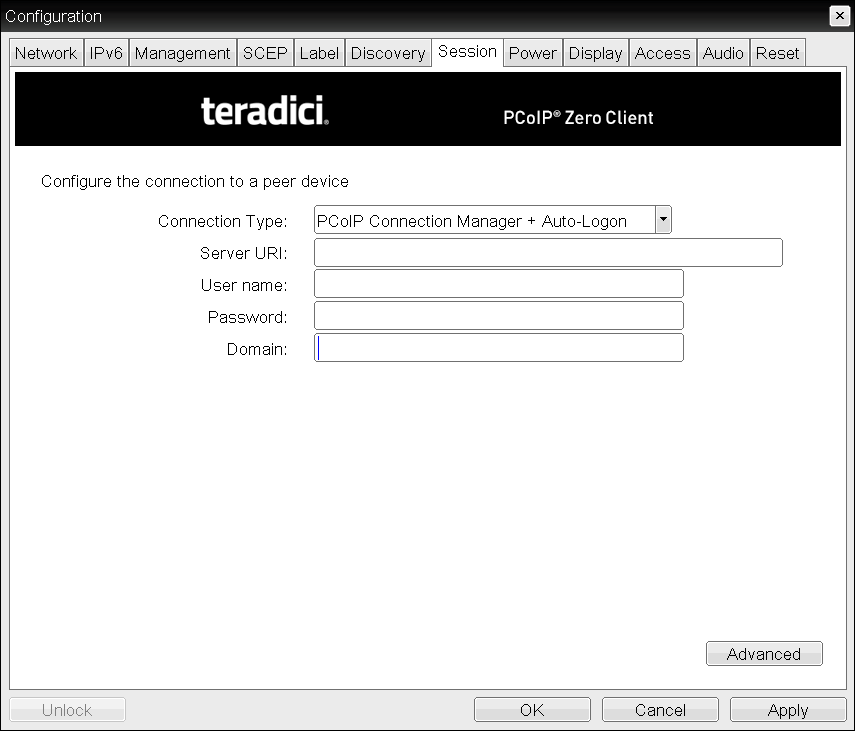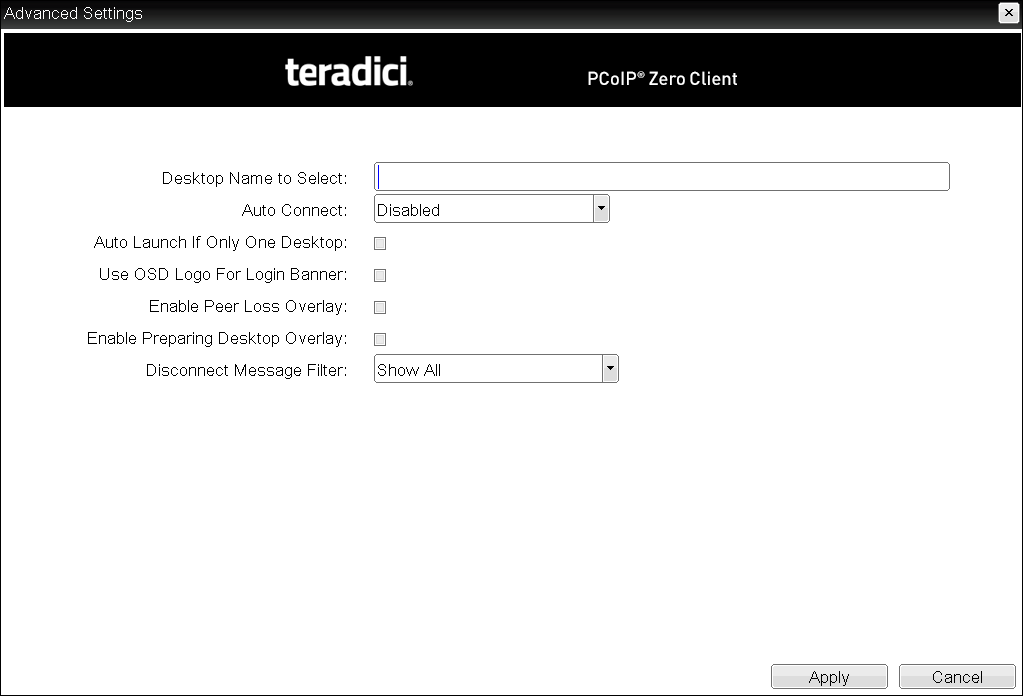OSD: PCoIP Connection Manager + Auto-Logon Session Settings¶
Select the PCoIP Connection Manager + Auto-Logon session connection type from the Options > Configuration > Session page to configure a client to automatically enter a user’s login details when a PCoIP Connection Manager is used as the PCoIP session broker, or when connecting directly to a Cloud Access Software host.
Click the Advanced button to configure advanced settings for this option.
Take precautions to secure PCoIP Zero Clients
Passwords are stored locally in retrievable form when PCoIP Zero Clients are configured with this session connection type. For this reason, it should not be used in high security environments. Ensure that you take precautions to prevent theft of the zero client if you do use this session connection type.

OSD Session Connection Type – PCoIP Connection Manager + Auto-Logon

Advanced Settings
The following parameters can be found on the OSD PCoIP Connection Manager + Auto-Logon page.
OSD PCoIP Connection Manager + Auto-Logon Parameters
| Parameter | Description |
|---|---|
| Server URI | Enter the Uniform Resource Identifier (URI) for the PCoIP Connection Manager or the Cloud Access Software host when connecting directly to Cloud Access Software. The URI must be in the form https://<host FQDN> or https://<ip address>. |
| User name | Enter the user name for the client (maximum number of characters is 128). This user name will be sent to the specified connection server. |
| Password | Enter the password for the client (maximum number of characters is 128). This password will be sent to the specified connection server. |
| Domain | Enter the domain for the client (maximum number of characters is 256). This domain will be sent to the specified connection server. |
| Desktop Name to Select | Enter the desktop name used by the client when starting a session. |
| Auto Connect | This field determines the client’s auto connect behavior after startup: Enabled: The client automatically connects with the connection server after startup and a PCoIP session ends, bypassing the OSD Connect page. Disabled: The client does not automatically connect with the connection server. Enabled With Retry On Error: The client will continuously attempt to contact the connection server. After a connection failure, the client waits before attempting to connect again. This wait time increases with each successive failure. The wait interval is not configurable. Devices running firmware 4.1.1 or lower do not support Retry On Error behavior and will always perform a single attempt to contact the connection server when this option is selected. After enabling Auto Connect, the client must be power-cycled for the change to take effect. |
| Auto Launch If Only One Desktop | When enabled, users are automatically connected to a provisioned desktop after user credentials are entered. This feature only applies to users who are entitled to a single desktop. It does not apply to users entitled to multiple virtual desktops. |
| Use OSD Logo for Login Banner | When enabled, the OSD logo banner appears at the top of login screens in place of the default banner. |
| Enable Peer Loss Overlay | When enabled, the 'Network Connection Lost' overlay appears on the display(s) when a loss of network connectivity is detected. Normal hypervisor scheduling delays can falsely trigger this message. |
| Enable Preparing Desktop Overlay | When enabled, the 'Preparing Desktop' overlay appears on the display(s) when users log in. This overlay provides assurance that login is proceeding if the desktop takes more than a few seconds to appear. |
| Disconnect Message Filter | This field lets you control what type of messages appear when a session is disconnected. There are three categories: Information: User- or administrator-initiated actions affecting the session:
You can choose to display:
|